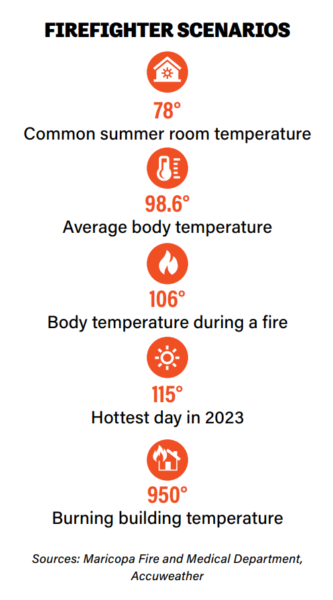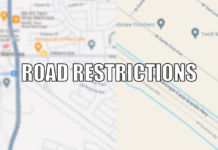![Prestige Landscaping Ignacio Valdez (foreground) and Gary Fields of Prestige Landscaping plant oleanders in 103-degree heat. [Bryan Mordt]](https://www.inmaricopa.com/wp-content/uploads/2023/08/BCM_2214-696x463.jpg)
In a rapidly growing city, progress takes no summer vacation. Many toil under a blazing sun or in stifling conditions. Drill operators, roofers, landscapers, HVAC technicians — the list goes on.
Fiber-optic installer Corey Triplett said he prefers working outdoors. He’s not the only one.
“I’ve been doing a lot of tradesman work since I was young, so I’ve always worked outside,” said Ignacio Valdez, a landscaper in Maricopa with Prestige Landscaping. “Working in the heat is definitely something that will wear you out throughout the day.”
Coworker Gary Fields agreed.
“I’ve always liked working outside,” he said. “It’s just the heat. The heat can get to you.”
The two said they often begin their workday as early as possible to avoid the most scorching afternoon stretch. But in central Arizona, even the wee hours of the morning quickly grow hot.
“I just continue to stay hydrated,” Fields said. “You do everything you can to prepare.”

For the local landscapers, preparation includes chugging water during and after work, eating well and being mindful of warning signs.
“We just anticipate knowing what’s going to happen with the heat throughout the day and look forward,” Valdez said. “The outside work, it’s a struggle if you don’t take care of each other.”
Firefighters, meanwhile, work in uniquely excruciating conditions. Active fires can reach 1,000 degrees and each member wears approximately 70 pounds of gear and protection, according to Maricopa Fire Corps volunteer Sherrie Hagemo.
Most firefighters spend 20 to 40 minutes at a time in a fire, which can raise core body temperatures to 104 degrees or higher — the temperature medical examiners say can be fatal. This can escalate to danger quickly.
“We want to cool them down,” Hagemo said.
Heat-related stress causes some firefighters to suffer seizures, cardiac arrest and even death. “We’ve seen that happen in other places,” Hagemo said.
To prevent this, she and other volunteers monitor crews’ health. They ensure each firefighter cycles through 10-minutes of cooling with wet compresses, soaking arms in cold water and drinking cool water with electrolytes.
Utility breaks energy use record
A heatwave wasn’t the only record-topper this summer.
Electrical District No. 3 broke previous records for energy use this summer.
The utility company saw a “multi-day record peak” demand for electricity in July, which topped at 263 megawatts July 25 — an 11% increase from the previous record set July 11 last year when the peak reached 237 megawatts.
![Gary Fields repairing and adjusting drip lines in 103° weather. [Bryan Mordt]](https://www.inmaricopa.com/wp-content/uploads/2023/08/BCM_1971-399x600.jpg)
ED3 General Manager Brian Yerges told InMaricopa the relentless heatwave caused the unprecedented energy consumption.
“It is clearly driven by the weather and the heat,” he said.
Yerges added continued growth in Maricopa and surrounding areas may have also contributed to the spike. The utility is used to annual usage upticks in recent years.
“For the last three years, we’ve seen our peak demand increase,” he said. “This year, we did see a larger increase than in previous years that is consistent with other utilities like SRP or APS.”
Powerhouse utilities in metro Phoenix, Salt River Project and Arizona Public Service, reported record usage that month as well, breaking multi-day records during the excessive heatwave.
Despite this, ED3 and other utilities reported “below average” outages thanks to the lack of summer storms.
“We typically have higher outages during the monsoon season with the wind and the rain,” Yerges said. “Those have a bigger impact than the heat.”
The utility also avoids disconnecting for nonpayment during the summer months, especially when an excessive heat warning goes into effect.
“We do not disconnect during any of the heat advisory days issued from the National Weather Service,” said Assistant General Manager Kari Woodward.
On days without a warning, the utility ups the threshold for dues before a shutoff.
“June through September, we will not disconnect for any (bill) below $300 regardless of what’s going on with the weather,” Woodward said. “We have that in place as a safety net for our customers.”
This story was first published as part of the heat safety package in the September edition of InMaricopa Magazine.






![City gave new manager big low-interest home loan City Manager Ben Bitter speaks during a Chamber of Commerce event at Global Water Resources on April 11, 2024. Bitter discussed the current state of economic development in Maricopa, as well as hinting at lowering property tax rates again. [Monica D. Spencer]](https://www.inmaricopa.com/wp-content/uploads/2024/04/spencer-041124-ben-bitter-chamber-property-taxes-web-218x150.jpg)

![3 things to know about the new city budget Vice Mayor Amber Liermann and Councilmember Eric Goettl review parts of the city's 2024 operational budget with Mayor Nancy Smith on April 24, 2024. [Monica D. Spencer]](https://www.inmaricopa.com/wp-content/uploads/2024/04/spencer-042424-preliminary-budget-meeting-web-218x150.jpg)


![Alleged car thief released without charges Phoenix police stop a stolen vehicle on April 20, 2024. [Facebook]](https://www.inmaricopa.com/wp-content/uploads/2024/04/IMG_5040-218x150.jpg)





